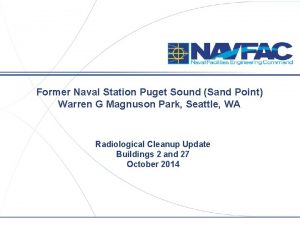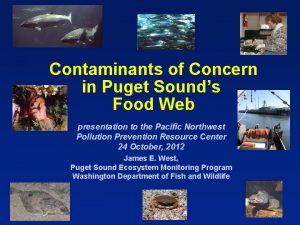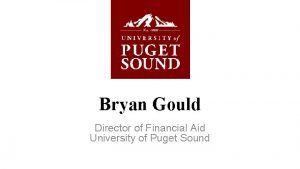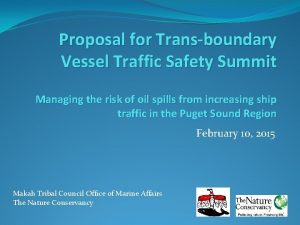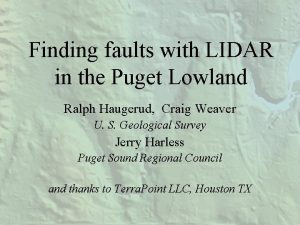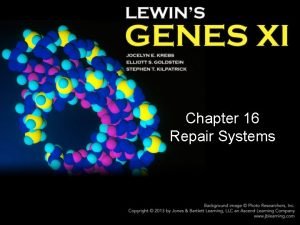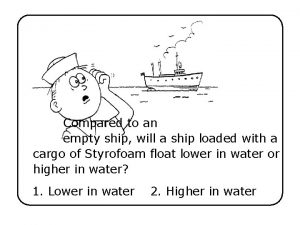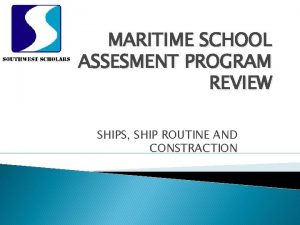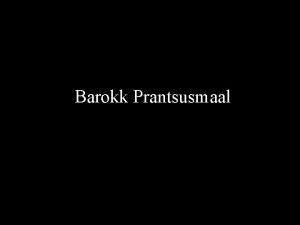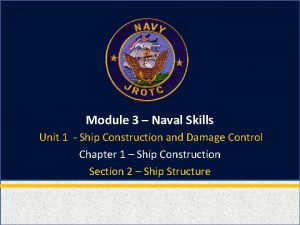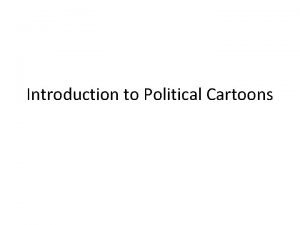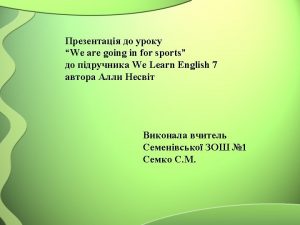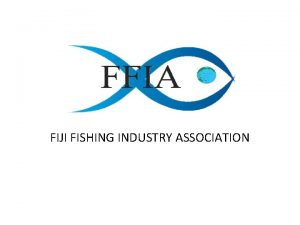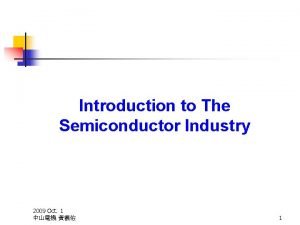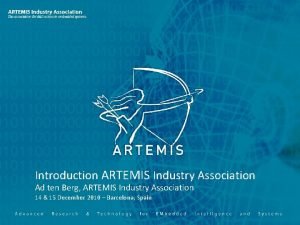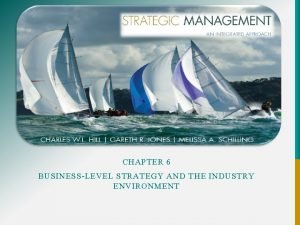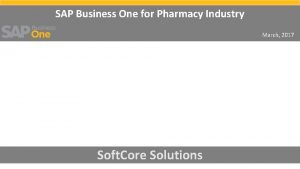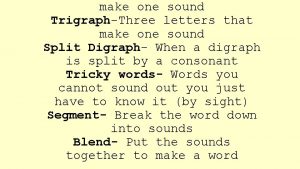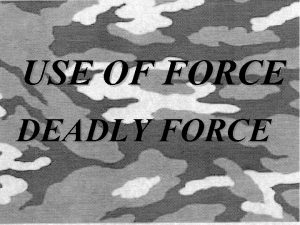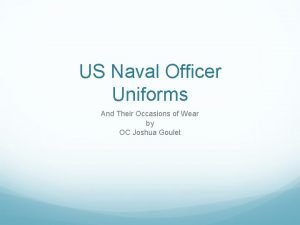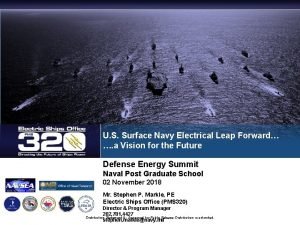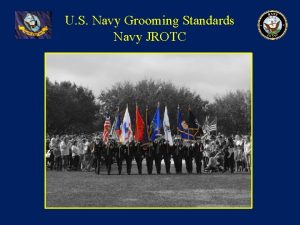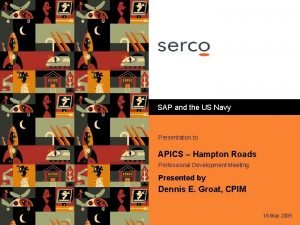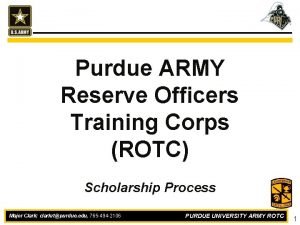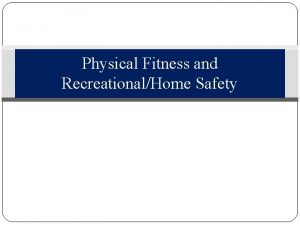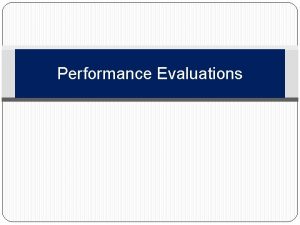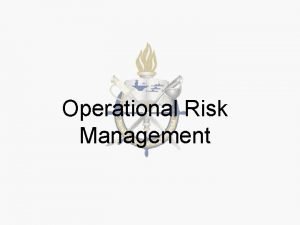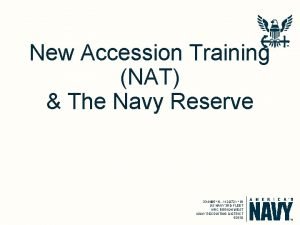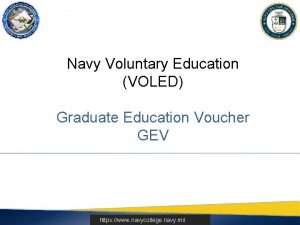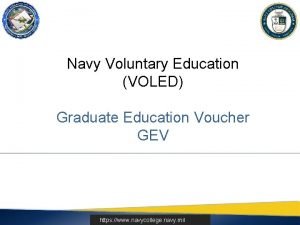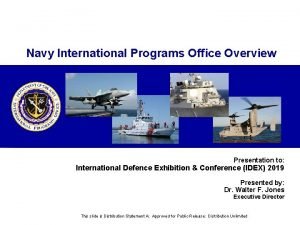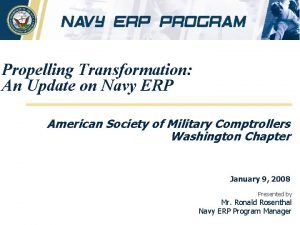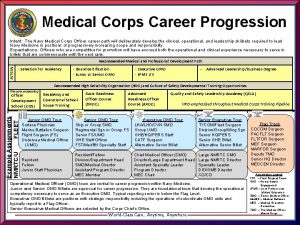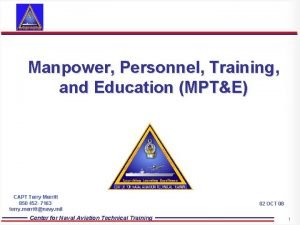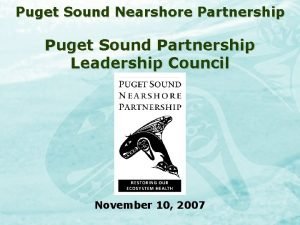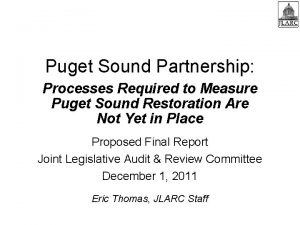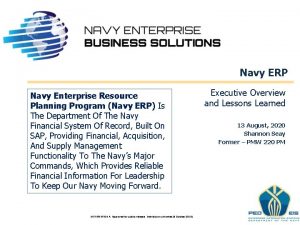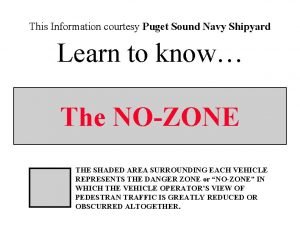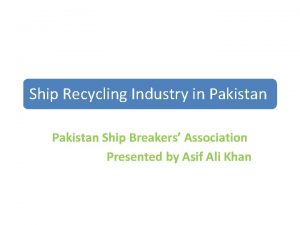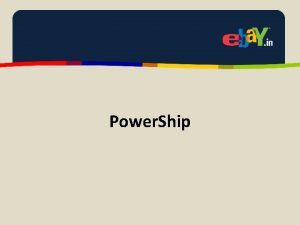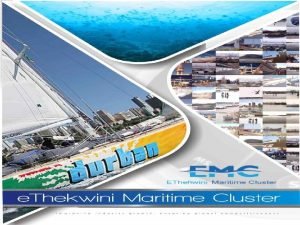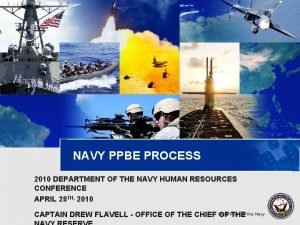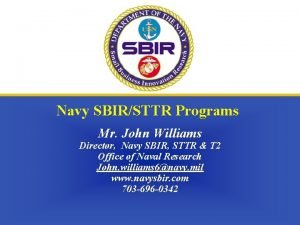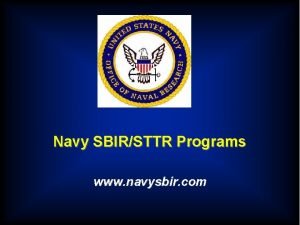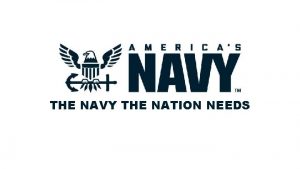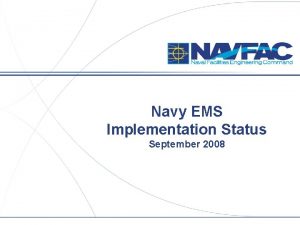Puget Sound Ship Repair Association Industry Navy One
































































- Slides: 64

Puget Sound Ship Repair Association Industry. Navy. One Team. Together Everyone Achieves More Fire Watch Training Program

This Fire Watch training program provides guidelines for the detection and deterrence of fire in the workplace. It also outlines the responsibilities of Fire Watches, Welders and Team Leaders. Only Qualified personnel may use this program for instructing and certifying Fire Watches. The Environmental Health and Safety Manager or Program Managers will ensure that the instructor is qualified. INTRODUCTION 2/22/2021 2

References NAVSEA Standard Item 009 -07 – Confined Space Entry, Certification, Fire Prevention and Housecleaning; accomplish NAVSEA Standard Item 009 -35 – Confined Space Entry, Certification, Fire Prevention Utilizing Military Fire Watches and Housekeeping; accomplish Seattle Fire Department (SFD Administrative Rule 26. 01. 04) – Cutting, Welding and other Hot Work on Marine Vessels 2/22/2021 3

Definitions Adjacent spaces – Those spaces in all directions from the subject space, including all points of contact, corners, diagonals, decks, tank tops, and bulkheads. Confined spaces – Any compartment of small size and limited access such as double bottom tank, cofferdam, or similar space which by virtue of its small size and confined nature can create or aggravate a hazardous condition. Enclosed space – Any space, other than a confined space, which is enclosed by a bulkhead and overhead. The term includes cargo holds, tanks, quarters, and machinery spaces. Fire watch – A person designated by the supervisor of the welding operation to watch for signs of fire. Such persons shall be familiar with Fire Department Permit Conditions, the area where the welding and cutting is to take place, and procedures for sounding an alarm in the event of fire. 2/22/2021 4

Definitions (Continued) Hot work – Hot work is any construction, alteration, repair, or ship breaking operation involving, welding, burning, brazing, soldering, heating, use of powder-actuated tools or similar spark, arc or fire-producing activity. Grinding, Drilling, abrasive blasting, or similar spark-producing operations are also considered hot work unless deemed otherwise by a Marine Chemist or when such operations are isolated physically from any atmosphere containing more than 10 percent of the lower explosive limit of a flammable or combustible substance, as determined by a Shipyard Competent Person. Marine Chemist – The holder of a valid Certificate issued by the National Fire Protection Association in accordance with the “Rules for Certification of Marine Chemists. ” 2/22/2021 5

Definitions (Continued) Level I Hot Work Permit – Level I permits are temporary permits issued for hot work in areas or compartments that are not on or near foam insulation; do not contain oil, waste oil or other petroleum products. Level I hot work areas normally will not require a Marine Chemist Certificate but inspection of the hot work area by a Shipyard Competent Person is always required. Such areas or compartments may include, but are not limited to: § Ballast tanks, chain lockers and voids. § Superstructures, deck house, galley and living spaces. § Shell plating, framing decks, bulkheads. § Main deck, dry cargo holds, dry stores and processing areas that are not insulated with flammable or combustible foam insulation. 2/22/2021 6

Definitions (Continued) Level II Hot Work Permit – Level II permits are temporary permits issued for hot work in hazardous areas or compartments that are insulated with foam, contain or have contained flammable or combustible vapors, coatings, fuel oils, hydraulic oil, lube oil, waste oil or other petroleum products. Level II hot work areas will require a Marine Chemist Certificate. Such hazardous areas or compartments may include, but are not limited to: § Fuel oil tanks and piping systems, including pumps, strainers, vents and its associated appurtenances. § Hydraulic, lube, slops or waste oil tanks and their associated piping systems. § Engine rooms, diesel generator rooms, reefer flats, machinery spaces, shaft alleys and steering gear compartments. 2/22/2021 7

Definitions (Continued) Level II Hot Work Permit (Continued) § Cargo tanks or compartments that contain or have contained hazardous materials including flammable or combustible gases, liquids or solids. § Sewage holding tanks and piping systems, including pumps and vents. § Foam-insulated compartments such as refrigerated cargo holds, fish holds or processing areas. § Work conducted on refrigeration and/or cooling systems using freon or ammonia. § Work on bulkheads and overheads directly adjacent to those compartments listed above. § Note: Certain hot work operations normally classified as Level I may be classified as Level II hot work if deemed necessary by a Marine Chemist. 2/22/2021 8

Definition and Classification of Fire - is the rapid oxidation of a substance often with the evolution of heat and light in varying degrees of intensities. A common misconception is that fire burns the actual solid or liquid fuel (for example, wood or organic solvent). However, it is the vapor given off by an object that burns. Heat causes objects to give off these flammable vapors (or gases). When the gases reach their ignition temperature, you see the light given off during the oxidation, known as fire. Fire itself generates more heat to the object, and thus an endless cycle begins until all of the gases have been exhausted from an object. All that remains of the object are particles or ash. 2/22/2021 9

Definitions (Continued) § Fuel oil tanks and piping systems, including pumps, strainers, vents and its associated appurtenances. § Hydraulic, lube, slops or waste oil tanks and their associated piping systems. § Engine rooms, diesel generator rooms, reefer flats, machinery spaces, shaft alleys and steering gear compartments. § Cargo tanks or compartments that contain or have contained hazardous materials including flammable or combustible gases, liquids or solids 2/22/2021 § Sewage holding tanks and piping systems, including pumps and vents. § Foam-insulated compartments such as refrigerated cargo holds, fish holds or processing areas. § Work conducted on refrigeration and/or cooling systems using Freon or ammonia. § Work on bulkheads and overheads directly adjacent to those compartments listed above. 10

Fire Tetrahedron or Pyramid Theory The fire tetrahedron or pyramid theory differs from the fire triangle by including the concept of the chemical chain reaction. This new concept below helps explain the action of some agents such as dry chemicals and halon. 2/22/2021 11

Fire Tetrahedron or Pyramid Theory Fuel: In both theories fuel is any solid, liquid, or gas that can combine with oxygen in the chemical reaction known as oxidation. Heat / Ignition Source: Combustion requires a level of energy that will cause an increase in molecular activity within a substance's chemical structure. Temperature is the measure of the molecular activity within a substance. Oxygen / Oxidizing Agent: Under most conditions, the agent will be oxygen in the air, but some materials release their own oxygen during combustion, such as sodium nitrate and potassium chlorate. Chain Reaction: Fuel molecules combine with oxygen in a series of successive intermediate stages, called branched chain reaction (nonlinear chain of atoms in which one or more series of atoms branches off another chain of atoms). Then the end product, combustion occurs. The intermediate stages are responsible for the evolution of flames. 2/22/2021 12

Classification of fires Class “A” (Alpha): Are those occurring in such ordinary combustible materials as wood, cloth, paper, upholstery and similar materials. (Anything that leaves an ash). 2/22/2021 13

Classification of fires Class “B” (Bravo): Are those occurring in the vapor air mixture over the surface of flammable liquids such as gasoline, jet fuels, diesel oil, fuel oil, paints, thinners, solvents, lubricating oils, and greases. 2/22/2021 14

Classification of fires Class “C” (Charlie): Are those occurring in electrical equipment or systems. 2/22/2021 15

Classification of fires Class “D” (Delta): Are those involving combustible metals such as magnesium, titanium, zirconium, sodium, lithium and potassium. 2/22/2021 16

Classification of fires Class “K” (Kilo): Cooking oils/fats/grease 2/22/2021 17

Preferred Extinguishing Agents Based on Classes Class A fires: Water-Based Extinguishers: Extinguishing agents include water, antifreeze, loaded stream, wetting agent, soda-acid, and foam. All except AFFF foam are to be used solely on Class A fires. Antifreeze, loaded stream, AFFF, and wetting agent all use water as a base to which chemicals are added to improve the extinguisher's performance. Both antifreeze and loaded stream agents are specially treated to withstand low temperatures. In wetting agents, a chemical is added to reduce the surface tension of the water so that it will spread and penetrate better. 2/22/2021 18

Preferred Extinguishing Agents Based on Classes Class B fires: Dry Chemical Extinguishers: Include sodium bicarbonate, potassium bicarbonate (Purple K), urea potassium bicarbonate (Monnex), potassium chloride based agents, and multipurpose dry chemicals, which may be used on Class A, B, and C fires. An ammonium phosphate-based agent is the only multipurpose dry chemical currently manufactured. 2/22/2021 19

Preferred Extinguishing Agents Based on Classes Class C fires: Carbon Dioxide Extinguishers (CO 2): Prevents combustion by displacing the oxygen in the air surrounding a fire and by cooling the fuel. Its principal advantage is that it does not leave a residue, a consideration that may be important in laboratories and in areas in which food is prepared. The rapid expansion and pressure reduction of the pressurized liquid CO 2 in the extinguisher's cylinder results in a cooling and refrigeration effect. The generation of static electricity occurs when CO 2 is released; therefore, ensure the bottle is grounded to the deck. 2/22/2021 20

Preferred Extinguishing Agents Based on Classes Class D fires: Dry Powder Extinguishers: The two most common agents are sodium chloride and G-1 powder. The sodium chloride can be used in an extinguisher or applied by hand. The G-1 must be applied by hand. When G-1 is applied to a metal fire, the heat of the fire causes the phosphorous compounds to generate vapors that blanket the fire and thus prevent air rich with oxygen from reaching the burning metal. The graphite, being a good conductor of heat, cools the material below its ignition temperature. 2/22/2021 21

Preferred Extinguishing Agents Based on Classes Class K fires: Wet Chemical Extinguishers: Specifically designed to supplement fire suppression in kitchens. These extinguishers are designed for coolking oil, fat and grease fires. Look for the letter “K” symbol if you need to extinguish a class “K” fire. 2/22/2021 22

Preferred Extinguishing Agents Based on Classes AFFF : A surfactant, when added to water, forms a solution that creates foam when discharged through an aspirating nozzle. On Class A fires, the agent both cools and penetrate to reduce temperatures below the ignition point. On Class B fires, it acts as a barrier to exclude oxygen from the surface of the fuel. 2/22/2021 23

Fire Extinguisher Check Points Prior to Use Preferred use on Class Charlie Fires (Electrical) § § 15 lb Red Bottle with Horn 2/22/2021 Ensure pin is in place. Ensure pin is sealed (small plastic tie). Check Horn & Hose for cracks/breaks. Check for inspection tag (up to date) Notes: Wear gloves when discharging a CO 2 bottle. The pressurized chemicals will form frost on the horn and hose (causing possible frost bite to exposed skin). When discharging bottle under pressure static electricity can occur. Keep bottle grounded to the steel deck. Bottle lasts approximately 45 seconds under normal use. CO 2 can be used on Class A, B and C fires. 24

Fire Extinguisher Check Points Prior to Use Preferred use on a Class Alpha Fires (Anything that leaves an ash) § § § Chrome 2 ½ gal tank with gage and hose 2/22/2021 Ensure pin is in place. Ensure pin is sealed (small plastic tie). Ensure bottle is properly charged. Check hose for cracks and breaks. Check for inspection tag (up to date). Ensure head is secured to bottle (not loose). Notes: Lasts approximately 1 min under normal use. Never use on Class B, C and K fires. 25

Procedure for Extinguishing Fires The P. A. S. S method shall be used “P” Pull the pin at the top of the extinguisher. The pin releases a locking mechanism and will allow you to discharge the extinguisher. 2/22/2021 26

Procedure for Extinguishing Fires “A” Aim at the base of the fire, not the flames. This is important. In order to put out the fire, you must extinguish the fuel. 2/22/2021 27

Procedure for Extinguishing Fires “S” Squeeze the lever slowly. This will release the extinguishing agent in the extinguisher. If the handle is released, the discharge will stop. 2/22/2021 28

Procedure for Extinguishing Fires “S” Sweep from side to side. Using a sweeping motion, move the fire extinguisher back and forth until the fire is completely out. Operate the extinguisher from a safe distance, several feet away, and then move towards the fire once it starts to diminish. Be sure to read the instructions on your fire extinguisher. Different fire extinguishers recommend you operate them from different distances. Remember: Aim at the base of the fire, not at the flames!!!! 2/22/2021 29

Fire Prevention and Control of Damage from Hot Work Processes General fire prevention precautions for hot work processes onboard US Naval Ships. § Hot work includes flame heating, welding, torch cutting, brazing or carbon arc gouging and/or any operation which produces temperatures of 400°F (204°C) or higher. § Operations not producing hot sparks or flame, (e. g. spark producing or arc producing tools or equipment, static discharge, friction, open flames or embers, impact, and non-explosion proof equipment such as lights, fixtures, or motors) are not considered hot work unless occurring in the presence of flammable liquids or in a flammable atmosphere. However, some naval ships and shipyards still require Hot Work Permits during these situations. 2/22/2021 30

Fire Prevention and Control of Damage from Hot Work Processes General fire prevention precautions for hot work processes onboard US Naval ships. (Continued) § Hot Work Classes: When alpha materials (ordinary combustibles such as wood, cloth, paper, rubber, and many plastics) are exposed, hot work is divided into two classes. These are: 2/22/2021 31

Fire Prevention and Control of Damage from Hot Work Processes Hot Work Classes (Continued) Class I: Most Hazardous Class produce either high energy sparks or slag that can be thrown or dropped at the work site or produce heat that can be transferred through the deck, overhead, bulkhead, or structure to a location not visible to the hot work operator. This includes: § § § 2/22/2021 Flame cutting Welding Plasma cutting Carbon Arcing / gouging Other hot spark or flame producing processes not included in Class II 32

Fire Prevention and Control of Damage from Hot Work Processes Hot Work Classes (Continued) Class II: Less Hazardous Class produce flames or minimal energy sparks or slag, which is generally localized to the immediate work area. This includes: § § Electric stud gun Tig Welding Torch brazing Grinding with abrasive disks on magnetic material Note: Due to its low energy output, abrasive grinding on 2/22/2021 non-magnetic material is not included in Class II. 33

Fire Prevention and Control of Damage from Hot Work Processes Fire Prevention Precautions During Hot Work § Any hot work operation can start a fire in combustible materials. It will be the responsibility of the hot worker and the supervisor to take precautions to prevent fires caused by the exposure of combustibles to the effects of hot work. § Do not perform hot work when flammable liquids of flammable atmospheres are present without specific instructions from a Marine Chemist. § Inspect the far side, other side of the bulkhead, deck, overhead, or other structures to ensure that hot work will not damage materials or equipment on the other side of the hot work operation. 2/22/2021 34

Fire Prevention and Control of Damage from Hot Work Processes Fire Prevention Precautions During Hot Work (Continued) § De-energize all electrical equipment exposed to the hot work. § Remove hazardous material, explosive materials, flammable liquids or vapors from the work area as well as taking suitable precautions against the accumulation of such materials. § Where practicable, relocate all combustibles at least 35 feet from the work site. § Where relocation is impracticable, protect combustibles with metal or guards and curtains to prevent sparks from going under the covers. This precaution is also important at overlaps where several covers are used to protect 2/22/2021 35

Fire Prevention and Control of Damage from Hot Work Processes Fire Prevention Precautions During Hot Work (Continued) § Protect openings for hot work processes that generate slag, weld splatter or sparks within 35 feet. Cover decks, bulkheads or overheads which can be a path for ignition sources in adjacent compartments, spaces or decks below. If the opening cannot be covered, a fire watch will be posted on the far side. § Protect intricate vulnerable machinery and equipment from falling sparks or other potential sources of fire with metal guards or curtains constructed of flame retardant material. Secure the protection in place before commencing hot work. 2/22/2021 36

Fire Prevention and Control of Damage from Hot Work Processes Fire Prevention Precautions During Hot work (Continued) § Blank off ducts and conveyor systems that might carry sparks to distant combustibles. § Protect the area near decks, bulkheads, partitions or overheads manufactured from combustible materials when hot work is being conducted near them. § If the work area is close enough to cause ignition by heat conduction, do not undertake hot work on pipes, other metal in contact with insulation or combustible decks, bulkheads, partitions or overheads. 2/22/2021 37

Fire Prevention and Control of Damage from Hot Work Processes Fire Prevention Precautions During Hot Work (Continued) § Notify the Ship’s Hot Work Control Officer before starting hot work. Hot work can only be conducted in or on fuel tanks, in spaces in which fuel tank vents terminate, or other confined spaces known to contain flammable fuel with the approval of a Marine Chemist. § Locate the nearest telephone and compartment/space occupied by ship’s force in case of an emergency. § Locate the nearest fire bottle in case your extinguisher does not function. 2/22/2021 38

Fire Prevention and Control of Damage from Hot Work Processes Fire Watches § In confined or enclosed spaces, machinery rooms, catapult rooms, bilges, and other locations proximate to flammable atmospheres (e. g. near fuel tank vents and sounding tubes) fire watches will be posted at the worksite when hot work is undertaken. After completion of the hot work operation, fire watches will remain on station for a minimum of 30 minutes, unless the Supervisor or Team Leader surveys the affected work area and determines there is no further fire/safety hazard. § Abrasive disk grinding on ferrous materials with a wheel larger than 3 inches in diameter typically throws large sparks long distances. A fire watch is recommended for large wheel grinding when class alpha materials (ordinary combustibles) are exposed. When doubts exist, the ship’s Hot Work Control officer will determine the need for a fire watch. 2/22/2021 39

Fire Prevention and Control of Damage from Hot Work Processes Fire Watches (Continued) § When any type of hot work is being performed on bulkheads, decks, or overheads where sparks or heat transfer may ignite combustibles on the opposite side, set a fire watch on the far side. § The hot worker and the supervisor are responsible for ensuring fire watches are in place prior to starting work. § Watches shall be equipped with personal protective equipment for the operation being conducted (e. g. appropriate eye protection goggles, glasses, face shield, helmet, respiratory protection, fire retardant clothing, etc. ). § When more than one fire watch is required, establish a means of communication between fire watches. The communication method could be hand radios, knocking on the bulkhead or any method that effectively communicates with the welder or fire watch. 2/22/2021 40

Fire Prevention and Control of Damage from Hot Work Processes Fire Watches (Continued) § The fire watch must not be assigned other duties while the hot work is in progress. However. After the minimum 30 minutes has expired, he/she may become productive. Moreover, cleanliness should be the primary concern since good house keeping is part of maintaining a safe environment, free from combustible material and trip hazards. § Are authorized to stop work if necessary and restore safe conditions within the hot work area. § Must be physically capable of performing these duties. § Authorized to fire watch for four (4) hot work operators at one time, only if no obstructions are in view of the hot work. 2/22/2021 41

Fire Prevention and Control of Damage from Hot Work Processes Fire Watch Reporting a Fire § When you are assigned as the fire watch aboard a ship, it’s important that you know where you are and how to escape in the event of an emergency. Knowing where you are also aids in reporting the location of an emergency. There are two things you should do as an employee when assigned to work a space aboard ship: § Look for the nearest ships telephone and know the ship's emergency phone number. § Locate the nearest space to where you will be working that will be occupied with Navy personnel. 2/22/2021 42

Fire Prevention and Control of Damage from Hot Work Processes Fire Watch Reporting a Fire (Continued) § When on ship the compartment number that you are assigned to looks like this (02 -185 -2 -L): § (02) is 2 nd deck above the main deck § (185) is the 185 th frame from the bow/front. § (2) is the port/left side of ship § (Even number = port / left side of ship) § (Odd number = starboard / right side of ship) § (L) indicates living quarters 2/22/2021 43

Fire Prevention and Control of Damage from Hot Work Processes Fire Watch Reporting a Fire (Continued) To help determine what space you are in (if unsure): § Look above the entrance door for the compartment number. § Look at the Hot/Cold work permits. § Look at the Competent Person log. § Look at the Marine Chemist Certificate. § Look on the bulkhead inside the space for the “bulls-eye” which is reflective with the compartment number. 2/22/2021 44

Fire Prevention and Control of Damage from Hot Work Processes Fire Watch Reporting a Fire (Continued) How to report a fire § § § Know the class of fire (Alpha, Bravo, Charlie, Delta and Kilo) Know the compartment number (location) Report the fire by locating nearest phone Know the ship’s emergency numbers Tell someone near you to report the class of fire to the ship’s quarterdeck Fire, Class (? ) Fire in Compartment ( ) § Report it to the Quarterdeck. 2/22/2021 45

Fire Prevention and Control of Damage from Hot Work Processes Fire Watch Reporting a Fire (Continued) fire NOTE Should your path of escape become threatened Should the fire extinguisher run out of agent Should the fire extinguisher prove ineffective Should you no longer be able to safely fight the incident LEAVE THE AREA IMMEDIATELY AND GET INFORMATION TO THE QUARTERDECK 2/22/2021 46

Preservative Coating Exposures Protection against toxic preservative coatings and residues § All surfaces covered with toxic preservatives in enclosed spaces will be stripped of such coatings for a distance of at least 4 inches from the area of heat application or the employees will be protected by air line respirators. § Employees will be protected by a filter type respirator during open-air hot work. § Before welding, cutting or heating is commenced in enclosed spaces on metals covered by soft and greasy preservatives, the following precautions will be taken: 2/22/2021 47

Preservative Coating Exposures Protection against toxic preservative coatings and residues (Continued) § A Competent Person will test the atmosphere in the space to ensure that it does not contain explosive vapors. If such vapors are determined to be present, no hot work will commence until such precautions have been taken to ensure that the welding, cutting or heating can be performed safely. § The preservative coatings will be removed for a sufficient distance from the area to be heated to ensure that the temperature of the un-stripped metal will not be appreciably raised. Flame or heat will not be used to remove soft and greasy preservative coatings. 2/22/2021 48

Preservative Coating Exposures Protection against toxic preservative coatings and residues (Continued) § Immediately after welding, cutting or heating is commenced in enclosed spaces on metal covered by soft and greasy preservatives, and at frequent intervals thereafter, a Competent Person will test to ensure that no flammable vapors are being produced. If such vapors are determined to be present, the operation will be immediately stopped and will not resume until such additional precautions have been taken to ensure that he operation can be safely resumed. 2/22/2021 49

Marine Chemist (MC) Requirements Before any project requiring a Level II Hot Work Permit starts, the Marine Chemist (MC) must be called in to inspect all spaces for oxygen content and Vapor/gases. The MC during his/her inspection will check above, below and around the initial spaces for any possible hazards and list instruction on the certification that must be followed before any hot work can begin. The MC certification is normally posted outside the space as well as a copy posted on the ship’s Quarterdeck. (See example of MC Certification attached) All personnel are responsible for reading, understanding and following the instruction as set forth by the MC. When the MC departs the ship, then it is up to the Competent Person (CP) to ensure that all spaces are maintained as per MC Certification instruction prior to work starting daily. The CP must ensure that the atmosphere in the work space is both safe for hot work and safe for personnel entry. 2/22/2021 50

Competent Person (CP) Requirements The CP will check all spaces on a daily basis for % of oxygen and % of explosive gases, fumes and/or vapors. The CP will record all reading and any instructions he/she deems necessary for the safety of personnel and prevention of any fire hazards. The CP log will be posted on the bulkhead outside the compartment tat QED personnel will be working. (See example of CP Log attached). It is the responsible of all personnel to look at the CP log daily to ensure the space is safe for workers and safe for hot work. Follow instruction as far as ventilation for the space, removal of any flammable material and type of fire bottle to be used for hot work being accomplished. NOTE: A MC and CP log safe for worker and safe for hot work typically reads: 20. 8 Oxygen 0 LEL explosive gases 0 H 2 S 0 Hydrocarbon 0 Carbon Monoxide 2/22/2021 51

SUMMARY Fire Watch Training: Fire Watches will be adequately trained. An adequately trained Fire Watch will: § Know how to determine if an extinguisher is fully charged and properly sealed. § Know the different classes of fires (Class A. B, C, D and K). § Know the type of extinguishing agent that is effective on each class of fire. § Know procedures and use appropriate personnel protection equipment. Normally, such equipment is provided for eye and breathing protection. § Demonstrate the ability to operate an extinguisher on both a flammable liquid and ordinary combustible type fires. Conduct a “Live Fire” evolution if permitted by Local procedures demonstrating proper use of fire extinguishers. 2/22/2021 52

SUMMARY § Know that the hot worker and the supervisor are responsible for inspecting all sides of a bulkhead or deck, ensuring that combustibles are removed to a safe distance from the hot work and ensuring the physical placement of the Fire Watch. § Know that he/she and the hot worker will ensure that openings and combustible that cannot be removed will be covered and protected with fire retardant coverings. § Know that he/she will signal the hot worker and others in the event of a fire. § Know that he/she is to report any fire to the Officer of the Deck at the quarterdeck if a fire occurs beyond his/her capacity to extinguish. 2/22/2021 53

SUMMARY § Know the ship’s alarm system (bell signals) and use of ship’s telephone system: § Ship’s alarm system (BELL) § Rapid ringing 2 -3 seconds-pause-1 rings== emergency fwd. § Rapid ringing 2 -3 seconds-pause-2 rings== emergency amidships § Rapid ringing 2 -3 seconds-pause-3 rings== emergency aft § § Know how to transmit an alarm by using the shipyard fire alarm systems or the ship's interior communication system. § Know the designation and the location of the compartment in which he/she is standing watch and that he/she is responsible for leading ship's force back to the fire if requested. § Know that before securing the watch, he/she will stand 30 minutes at the hot work site after hot work has been completed. 2/22/2021 54

SUMMARY § Know the procedures for confinement of hot work, including use of welder’s curtains. § Be familiar with the hot work permit system in effect, what the system is intended to accomplish and who will monitor the performance. § Know the recognition of the adverse health effects that may be caused by exposure to fire. 2/22/2021 55

QUALIFICATION TEST The following Fire Watch Qualification Test is provided and can be used for certification purposes if desired. (See next slide) 2/22/2021 56

Fire Watch Qualification Test (You must score a minimum of 70% on this test to qualify as a Fire Watch) Name: ______________ Date: _______ 1) Fire burns the actual solid or liquid fuel (for example, wood or organic solvent a. True 2) Fires are classified by a numbering system. a. True 3) b. False What are the four components that make up the fire tetrahedron? a. b. c. d. 2/22/2021 b. False _____________________________________ 57

4) All portable fire extinguishers are capable of extinguishing all classes of fire. a. 5) True b. False What are the five classifications of fires? (Chose from the following) a. CO 2, AFFF, Water, PKP b. Charlie, Delta, Bravo, Alpha, Kilo c. 1, 2, 3, 4 d. PKP, Dry Chemical, Water, Dry Powder 6) Class Alpha fires consist of Combustible Material such as: a. Magnesium, Wood, Electrical components, Gasoline b. Gasoline, Jet Fuels, Fuel Oil, Paints c. Wood, Paper, Cloth, Upholstery d. Titanium, Paints, Woods, Fuels 2/22/2021 58

7) You find a fire in the incipient stage, what do you do? a. Stop hot work, extinguish the fire, notify the Safety Department b. Don’t worry about it until it gets bigger c. Immediately evacuate the ship d. Call the Fire Department 8) When aiming the hose from a fire extinguisher, you should point it at the top of the flames to smother the fire. a. True 9) b. False List four examples of Hot Work Class 1: a. _____________________ b. _____________________ c. _____________________ d. _____________________ 2/22/2021 59

10) List three examples of Hot Work Class II; a. _____________________ b. _____________________ c. _____________________ 11) Class II grinding operations are in progress, however, other work is going on in the space which is accumulating trash. What is the minimum distance combustible material must be relocated from the grinding operations? a. 15 feet b. 25 feet c. 35 feet d. 45 feet 12) The Team Leader/Foreman asked you to assist the welder in compartment 2 -100 -1 -L. Prior to the start of your duties, what two paperwork items are required prior to the start of hot work? a. _________________________ b. _________________________ 2/22/2021 60

14) Explain why you must stay a minimum of 30 minutes after any class of hot work. ______________________________________________________ 15) The smoke produced by fire is not considered hazardous. a. True 16) As a Fire Watch, you have the authority to stop hot work if you see something unsafe. a. True 17) b. False Fire Watch personnel can perform other duties while on fire watch. a. True 18) b. False A person conducting hot work can act as his or her own fire watch. a. True 2/22/2021 b. False 61

19) A fire watch must be physically capable of performing all tasks of a fire watch job. a. 20) True b. False The fire watch Personal Protective Equipment and gear consist of which of the following? a. Hard Hat, Safety glasses (tinted and non-tinted). b. Leather palm gloves, respirator, steel toe shoes. c. Flashlight and paint scraper. d. All of the above. 21) Fill in the blanks below: When checking the surrounding area, check for the nearest ______________, ____________ and _______________ being occupied. Ensure _____________ covers the space you are working and flammables/combustibles are removed at least _____ feet from hot work area. fire bottle, space, hot work chit, 35, telephone 2/22/2021 62

QUALIFICATION TEST ANSWER KEY Fire Watch Qualification Test Answer Key 1) 2) 3) 4) 5) 6) 7) 8) 9) 2/22/2021 b. False Fuel, Ignition Source, Oxidizing Agent, Chain Reaction b. False b. Charlie, Delta, Bravo, Alpha, Kilo c. Wood, Paper, Cloth, Upholstery a. Stop hot work, extinguish the fire, notify the Safety Department b. False Flame cutting, Welding, Plasma cutting, Arcing and gouging, electric arc welding, thermal spraying, other hot spark producing process not included in Class II. 63

QUALIFICATION TEST ANSWER KEY (Continued) 10) Stud welding with an electric stud gun, GTAW, Torch brazing, Ferrous metal grinding with abrasive disks. 11) c. 35 feet 12) Daily approved hot work chit by Ship’s Force and Marine Chemist’s certificate updated by a Shipyard Competent Person. 13) Protection of personnel and possible re-flashes. 14) b. False 15) a. True 16) b. False 17) b. False 18) a. True 19) d. All of the above 20) Fire bottle, Telephone, Space, Hot Work Chit, 35 2/22/2021 64
 Puget sound health care
Puget sound health care Tedx puget sound
Tedx puget sound Puget sound energy investor relations
Puget sound energy investor relations Naval station puget sound
Naval station puget sound Puget sound lidar consortium
Puget sound lidar consortium Puget sound food web
Puget sound food web University of puget sound financial aid
University of puget sound financial aid Puget sound safety summit
Puget sound safety summit Puget sound lidar consortium
Puget sound lidar consortium Lewis moon snail
Lewis moon snail Sr 509 extension
Sr 509 extension Base excision repair
Base excision repair Rec a
Rec a A boat full of scrap iron floats
A boat full of scrap iron floats Ship routine
Ship routine Barokk skulptuur
Barokk skulptuur Navy vessel one feels constricted in
Navy vessel one feels constricted in The trust giant's point of view meaning
The trust giant's point of view meaning This way that way over the irish sea
This way that way over the irish sea “a sound mind is in a sound body”
“a sound mind is in a sound body” 210 decibels
210 decibels One god one empire one religion
One god one empire one religion Little dog run
Little dog run One king one law one faith
One king one law one faith One god one empire one emperor
One god one empire one emperor One ford
One ford See one do one teach one
See one do one teach one See one, do one, teach one
See one, do one, teach one Structure of twelfth night
Structure of twelfth night See one do one teach one
See one do one teach one Asean tourism strategic plan
Asean tourism strategic plan Graphic organizer with the aims of la liga filipina
Graphic organizer with the aims of la liga filipina Localization industry standards association
Localization industry standards association Fiji fishing industry association
Fiji fishing industry association Fusion industry association
Fusion industry association European biomass industry association
European biomass industry association Itrs semiconductor
Itrs semiconductor Semiconductor industry association
Semiconductor industry association Artemis industry association
Artemis industry association Artemis industry association
Artemis industry association Artemis slogan
Artemis slogan Fragmented industry
Fragmented industry Sap business one for chemical industry
Sap business one for chemical industry Three letters that make one sound
Three letters that make one sound Repetition of beginning consonant sounds
Repetition of beginning consonant sounds Sibilance vs alliteration
Sibilance vs alliteration Deadly force definition navy
Deadly force definition navy New navy pt uniform
New navy pt uniform Distributed energy storage
Distributed energy storage Navy regulation haircut
Navy regulation haircut Navy sap training
Navy sap training Purdue rotc
Purdue rotc Navy male prt standards
Navy male prt standards Navyfitrep.com
Navyfitrep.com 5 step orm
5 step orm Navy reserve regions
Navy reserve regions Navy voled
Navy voled Navy graduate education voucher
Navy graduate education voucher Core value courage
Core value courage Navy international program office
Navy international program office Navy exchange flyer
Navy exchange flyer Us navy erp
Us navy erp Nato orders
Nato orders Navy supply corps officer career path
Navy supply corps officer career path Ammt navy
Ammt navy



